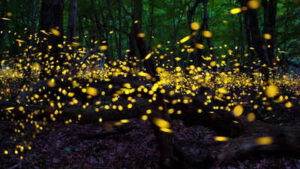 Fireflies, once a common sight lighting up summer nights, are rapidly disappearing from landscapes worldwide, prompting warnings from researchers that the current generation may be the last to witness their enchanting glow.
Fireflies, once a common sight lighting up summer nights, are rapidly disappearing from landscapes worldwide, prompting warnings from researchers that the current generation may be the last to witness their enchanting glow.
Fireflies, scientifically classified under the Lampyridae family, include over 2,000 species known for their bioluminescent displays used primarily during mating rituals. Their soft, glowing light has long fascinated humans and holds cultural significance in regions such as Japan, where dedicated parks protect their habitats. However, these remarkable insects are now facing severe survival threats.
Habitat loss remains one of the primary factors driving their decline. Fireflies thrive in damp woodlands, marshes, and wetlands, where their larvae develop beneath soil and leaf litter. Urban development, deforestation, and agricultural expansion have led to the destruction and fragmentation of these critical habitats, reducing the spaces where fireflies can live, breed, and feed.
Light pollution poses another major threat. As artificial lighting from urban infrastructure intensifies, the natural bioluminescent signals used by fireflies for mating are disrupted. The interference caused by streetlights, vehicle headlights, and billboards diminishes their ability to locate mates, leading to reproductive failures and declining populations. Studies suggest that light pollution is now among the fastest-growing risks to firefly survival, surpassing even habitat degradation in some areas.
Additionally, the widespread use of pesticides in farming has a detrimental impact on firefly numbers. These chemicals not only harm fireflies directly but also diminish populations of snails and slugs—the primary food source for firefly larvae. Contaminated water bodies further degrade the ecosystems fireflies depend on, affecting their entire life cycle.
Climate change adds to the crisis by altering environmental conditions essential for firefly development. Shifts in temperature and precipitation patterns disrupt the timing of mating seasons and reduce the availability of suitable breeding and feeding grounds. Such environmental mismatches could make reproduction increasingly difficult in the future.
Conservation efforts are underway to halt this alarming trend. Measures include restoring damaged habitats such as wetlands and forests, reducing light pollution in sensitive areas, promoting sustainable agricultural practices with minimal pesticide use, and raising public awareness about the importance of protecting these unique insects.
The decline of fireflies serves as a stark indicator of broader ecological distress, highlighting the urgency for comprehensive environmental protection to preserve not only these luminous insects but also the health of entire ecosystems they inhabit.
